
Dietes is a genus of rhizomatous plants of the family Iridaceae, first described as a genus in 1866. Common names include wood iris, fortnight lily, African iris, Japanese iris and butterfly iris, each of which may be used differently in different regions for one or more of the six species within the genus.
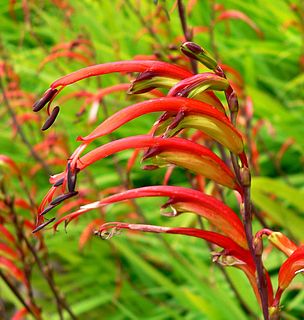
Chasmanthe is a genus of flowering plants in the family Iridaceae, first described in 1932. It is endemic to Cape Province in South Africa. It is widely grown as an ornamental and naturalized in various locations.
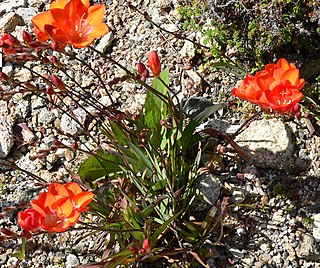
Tritonia is a genus of flowering plants in the iris family first described as a genus in 1802. They are naturally distributed across southern Africa, with a high concentration of species in Cape Province of western South Africa. The genus is closely related to the genus Ixia.

Dierama is a genus of flowering plants in the family Iridaceae. Common names include hairbells, angel's fishing rod, fairybells, and wandflowers in English and grasklokkies in Afrikaans. They are native to Africa, with most occurring in the southern regions of the continent. The center of diversity is the province of KwaZulu-Natal in eastern South Africa.

Geissorhiza is a genus with 103 species described to date of deciduous perennial flowering plants in the family Iridaceae first described as a genus in 1803. The entire genus is endemic to Cape Province of western South Africa. The genus name is derived from the Greek words geisson, meaning "tile", and rhizon, meaning "root".
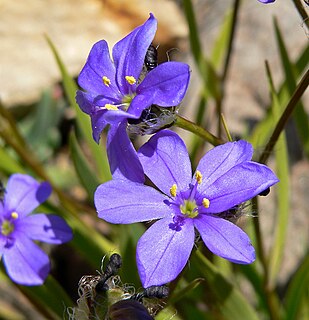
Aristea is a genus of evergreen, perennial and rhizomatous species of flowering plants in the family Iridaceae, first described in 1789. The genus is distributed in tropical and southern Africa, as well as Madagascar. The genus name is derived from the Greek word arista, meaning "awn".

Crocoideae is one of the major subfamilies in the family Iridaceae.
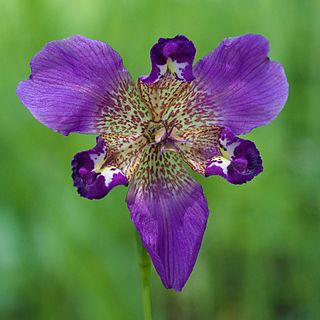
Alophia is a small genus of perennial, herbaceous and bulbous plants in the family Iridaceae. The genus comprise five known species that occur from the South-central United States as well as in Mexico, Central America, and parts of South America.
Cyanixia is a genus of plants in the Iridaceae, first described in 2003. It contains only one known species, Cyanixia socotrana, a perennial, herbaceous and bulbous plant species endemic to the Island of Socotra in the Indian Ocean, part of the Republic of Yemen.
Devia is a genus of plants in the family Iridaceae first described in 1990. It contains only one known species, Devia xeromorpha, endemic to the southwestern part of Cape Province in South Africa. The genus was named in honour of the South African botanist and academic, Miriam Phoebe de Vos.
Zygotritonia is a genus of herbaceous, perennial and bulbous plants in the family Iridaceae. It contains four species distributed in Tropical Africa. The genus name is derived from the word zygomorphic, and the apparent resemblance to some species in the genus Tritonia.
Xenoscapa is a genus of herbaceous, perennial and bulbous plants in the family Iridaceae. It consists of only two species distributed in Africa, and is closely related to the genera Freesia. The genus name is derived from the Greek words xenos, meaning "strange", and scapa, meaning "flowering stem".
Hesperoxiphion is a genus of flowering plants in the family Iridaceae, first described as a genus in 1877. It is native to northwestern South America. The genus name is derived from the Greek words hesperos, meaning "western", and xiphos, meaning "sword".
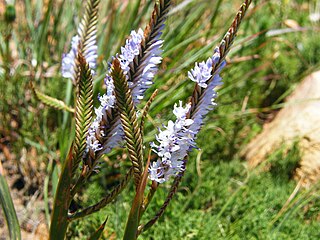
Micranthus is a genus of flowering plants in the family Iridaceae. The entire genus is endemic to Cape Province in South Africa.
Pillansia is a genus of flowering plants in the family Iridaceae, first described as a genus in 1914. It contains only one known species, Pillansia templemannii, endemic to Cape Province in South Africa.
Radinosiphon is a genus of flowering plants in the family Iridaceae first described as a genus in 1932. It is native to southern + southeastern Africa.
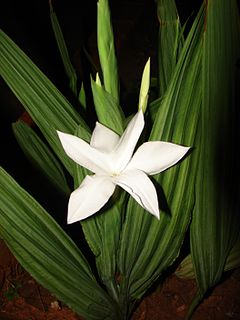
Savannosiphon is a genus of flowering plants in the family Iridaceae, first described as a new species in 1980. It contains only one known species, Savannosiphon euryphylla, native to tropical Africa.
Thereianthus is a genus of flowering plants in the family Iridaceae, first described as a genus in 1941. The entire genus is endemic to Cape Province in South Africa.

Trimezia is a genus of flowering plants in the family Iridaceae, native to the warmer parts of southern Mexico, Central America, South America, Florida, and the West Indies. Trimezia is placed in the tribe Trimezieae. The division of the tribe into genera has varied considerably. In one approach, it contains only the genus Trimezia, which then includes the genera Neomarica, Pseudotrimezia and Pseudiris. In other approaches, two to five genera are recognized, sometimes also including the genus Deluciris.
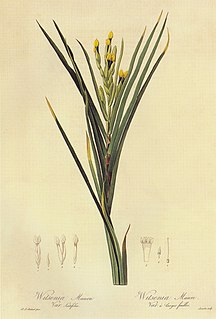
Witsenia is a genus of flowering plants in the family Iridaceae, first described as a genus in 1782. There is only one known species, Witsenia marua, endemic to Cape Province in western South Africa.












